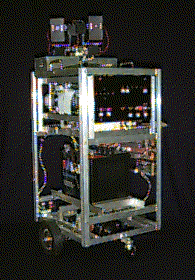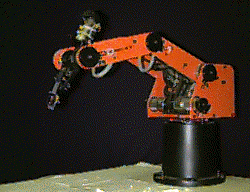

A variety of equipment is available to people undertaking COMP4411. From large commercially available robots to tools and components. As well, there is space on Floor 3 of K17 which includes a large open space for robots to roam, a number of desktop computer systems and a small workshop with tools to facilitate construction of equipment.

We have three PIONEER 2-DX mobile robotic platforms with extended PC104+ with PCI bus and multiple PC104 accessory cards. In addition to forward and rear sonar rings, our P2-DXs have wireless Ethernet, pan-tilt-zoom camera systems connected to frame-grabber cards. Two of them have laser range-finders.

We have 11 Operation Rug Warrior Robots. A 12th is used for spares and special projects.
A rug Warrior is a small robot based on a 68HC11 micro-controller. It is programmed in a dialect of C called Interactive C. There are libraries as well that allow control over the motors and sensors of the robot. As well they are equipped with an in-house designed expansion board that provides some extra features.
The Rug Warrior has two independent wheels, each with shaft encoder, 2 forward facing IR obstacle detectors, a plastic shell with bump sensors, two forward facing light sensors, a microphone and a speaker.

Originally designed and built by George Katz, a graduate of the School, CURI-III is a wheeled robot with stereo black & white cameras. Originally based on an Intel 486 DX33 processor with 8M of RAM running DOS, with an early VideoBlaster for frame grabbing, it has changed and will continue to change. Currently it uses a 200MHz Pentium with 32M of RAM and twin BT848 frame grabber cards connected to two B&W cameras on a pan-tilt head..
A feature of CURI is that its motors and camera head are controlled by small micro-controller boards, based on the 68HC11.
The motor control board supports PWM control of two wheels (left and right), shaft encoders for each wheel and some infra-red bump sensors, and these bump sensors have been linked to the motor control, so that proximity to an object can halt the motors. The motor HC11 also has enough smarts to be able to accept a command to go a specified number of 'ticks' for each wheels shaft encoder.
The camera head consists of two small B&W cameras, each mounted on its own pan/tilt head. In all 5 small servos control the two cameras. The servos are controlled by the second HC11. This board has available 8 ADC inputs as well as a reasonable number of digital IO inputs & outputs.

a mechanical arm
Recently one student 'coupled' the arm to a
Nintendo PowerGlove, making it essentially a waldo. It has also been used
in several remote control and teleoperation projects . For example, by
being controlled by camera from a computer connected via the Internet.

A simple 6-legged robot, Stumpy was originally built as a cheap device that could be used for a final year student project in machine learning. Although Stumpy was a prototype, it worked very well in its area of use (learning to walk). In normal operation it is tethered to a host machine and has an external power supply.
The original Stumpy has been retired, but he has two descendents, one called Stumpy another called Spymut. Spymut has had radio control added and can walk autonomously.
We have a number of constructed microcontrollers cards that can be used in
projects. Some are 68HC11 based Others are AVR based. These cards have a
variety of features and often include:
Ram and EEPROM
Eight 8-bit ADC inputs
Eight digital bi-directional bits
Eight digital outputs
a variety of counters and timers
a serial port (RS232) and a serial peripheral port
As well, we are able to design and build our own custom microcontroller cards in-house.
Three Black and White CCD cameras are used for vision experiments. As well a number of Frame-grabber cards are installed in the Lab's Desktop machines
There is a small in-lab network of desktop workstations. Mainly Pentium 150MHz machines running RedHat Linux 7.0.